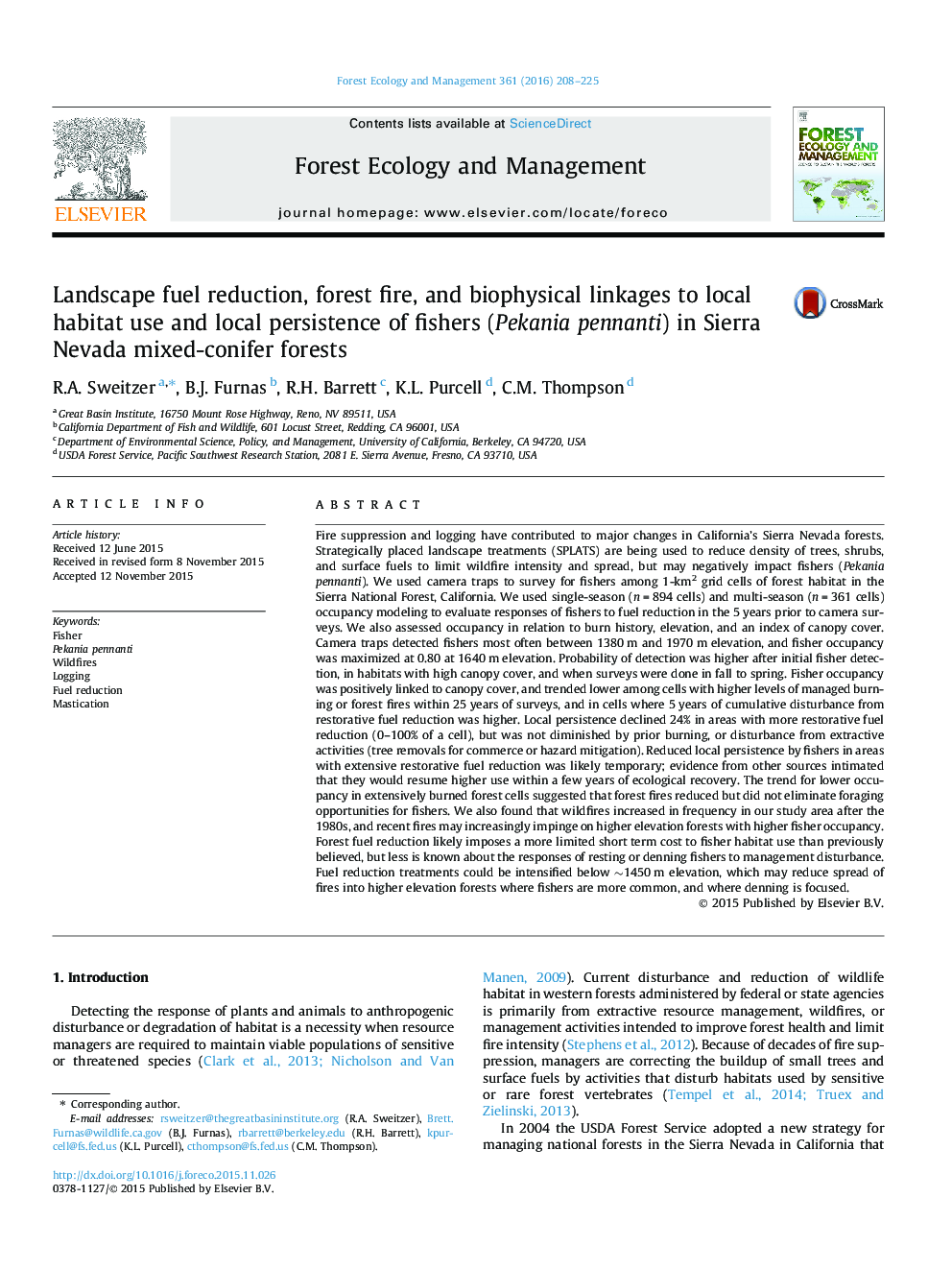| کد مقاله | کد نشریه | سال انتشار | مقاله انگلیسی | نسخه تمام متن |
|---|---|---|---|---|
| 6542449 | 159160 | 2016 | 18 صفحه PDF | دانلود رایگان |
عنوان انگلیسی مقاله ISI
Landscape fuel reduction, forest fire, and biophysical linkages to local habitat use and local persistence of fishers (Pekania pennanti) in Sierra Nevada mixed-conifer forests
دانلود مقاله + سفارش ترجمه
دانلود مقاله ISI انگلیسی
رایگان برای ایرانیان
کلمات کلیدی
موضوعات مرتبط
علوم زیستی و بیوفناوری
علوم کشاورزی و بیولوژیک
بوم شناسی، تکامل، رفتار و سامانه شناسی
پیش نمایش صفحه اول مقاله

چکیده انگلیسی
Fire suppression and logging have contributed to major changes in California's Sierra Nevada forests. Strategically placed landscape treatments (SPLATS) are being used to reduce density of trees, shrubs, and surface fuels to limit wildfire intensity and spread, but may negatively impact fishers (Pekania pennanti). We used camera traps to survey for fishers among 1-km2 grid cells of forest habitat in the Sierra National Forest, California. We used single-season (n = 894 cells) and multi-season (n = 361 cells) occupancy modeling to evaluate responses of fishers to fuel reduction in the 5 years prior to camera surveys. We also assessed occupancy in relation to burn history, elevation, and an index of canopy cover. Camera traps detected fishers most often between 1380 m and 1970 m elevation, and fisher occupancy was maximized at 0.80 at 1640 m elevation. Probability of detection was higher after initial fisher detection, in habitats with high canopy cover, and when surveys were done in fall to spring. Fisher occupancy was positively linked to canopy cover, and trended lower among cells with higher levels of managed burning or forest fires within 25 years of surveys, and in cells where 5 years of cumulative disturbance from restorative fuel reduction was higher. Local persistence declined 24% in areas with more restorative fuel reduction (0-100% of a cell), but was not diminished by prior burning, or disturbance from extractive activities (tree removals for commerce or hazard mitigation). Reduced local persistence by fishers in areas with extensive restorative fuel reduction was likely temporary; evidence from other sources intimated that they would resume higher use within a few years of ecological recovery. The trend for lower occupancy in extensively burned forest cells suggested that forest fires reduced but did not eliminate foraging opportunities for fishers. We also found that wildfires increased in frequency in our study area after the 1980s, and recent fires may increasingly impinge on higher elevation forests with higher fisher occupancy. Forest fuel reduction likely imposes a more limited short term cost to fisher habitat use than previously believed, but less is known about the responses of resting or denning fishers to management disturbance. Fuel reduction treatments could be intensified below â¼1450 m elevation, which may reduce spread of fires into higher elevation forests where fishers are more common, and where denning is focused.
ناشر
Database: Elsevier - ScienceDirect (ساینس دایرکت)
Journal: Forest Ecology and Management - Volume 361, 1 February 2016, Pages 208-225
Journal: Forest Ecology and Management - Volume 361, 1 February 2016, Pages 208-225
نویسندگان
R.A. Sweitzer, B.J. Furnas, R.H. Barrett, K.L. Purcell, C.M. Thompson,